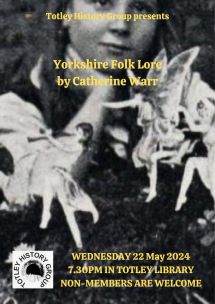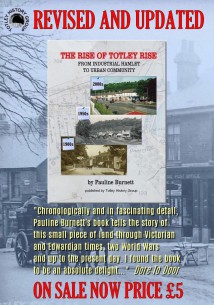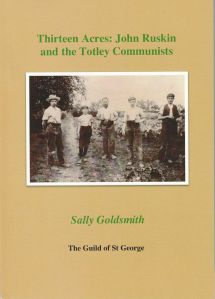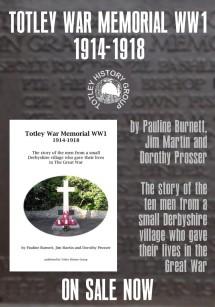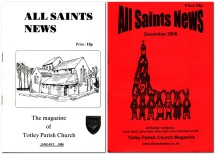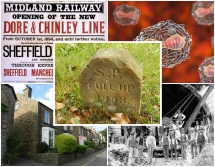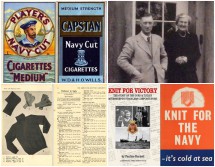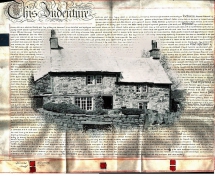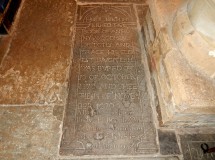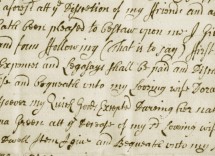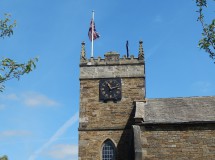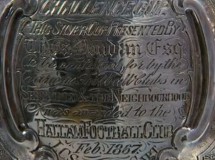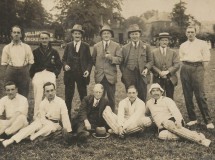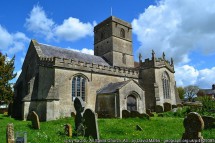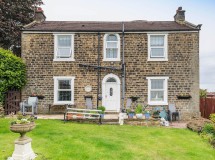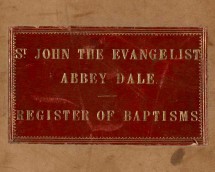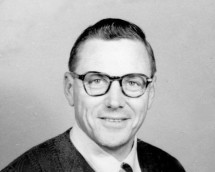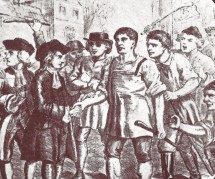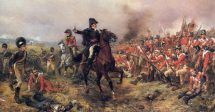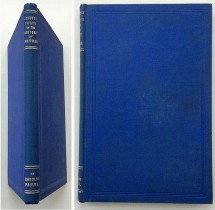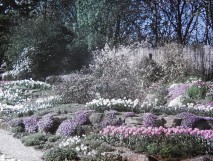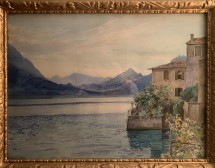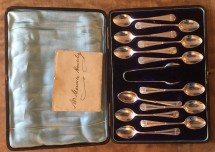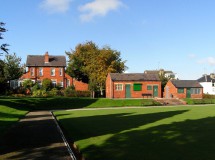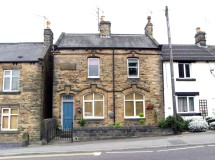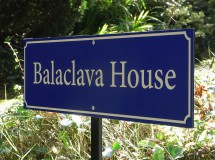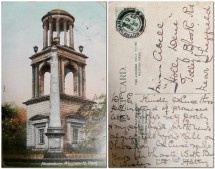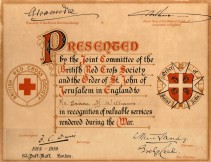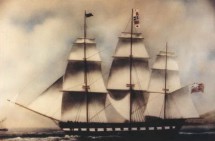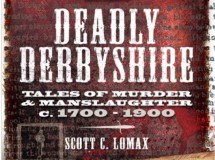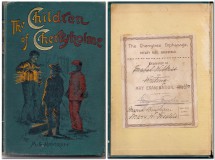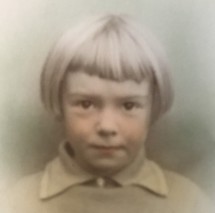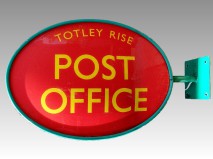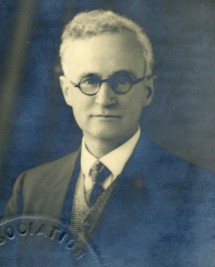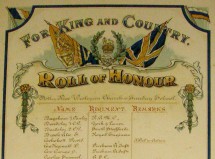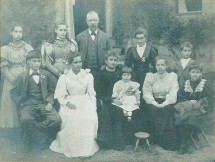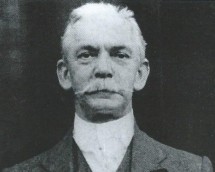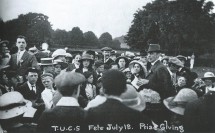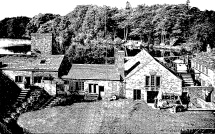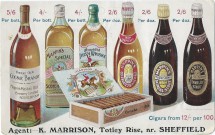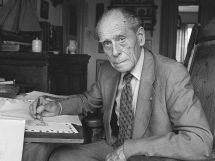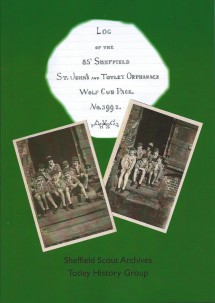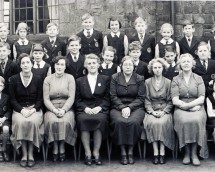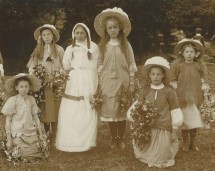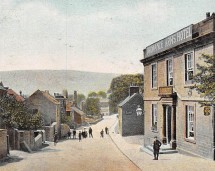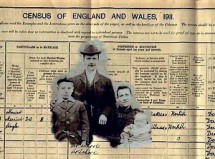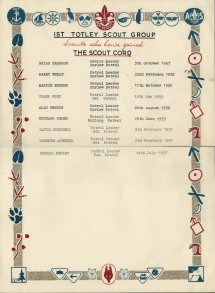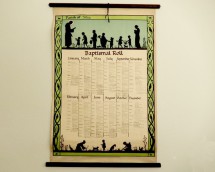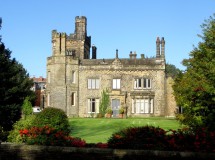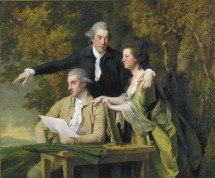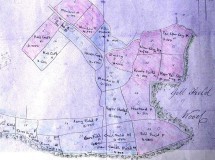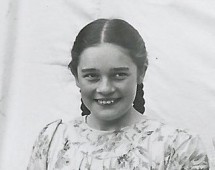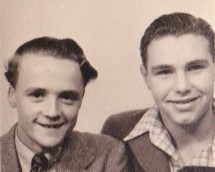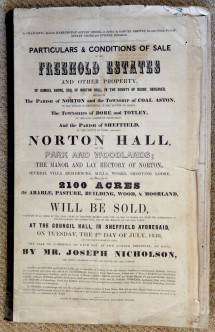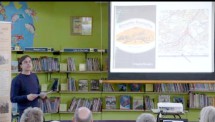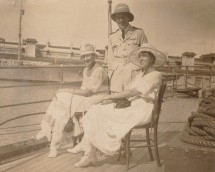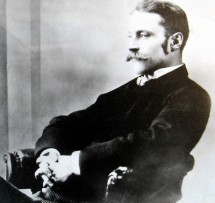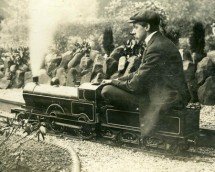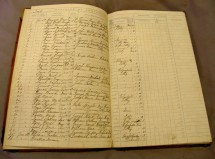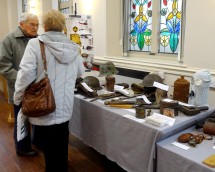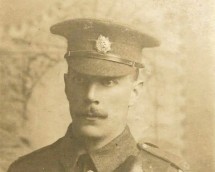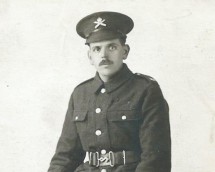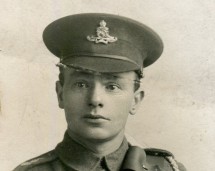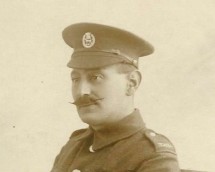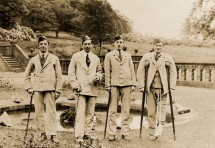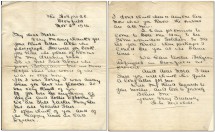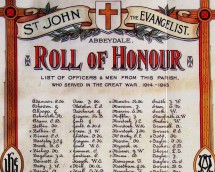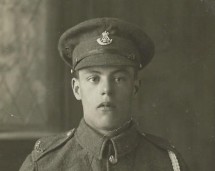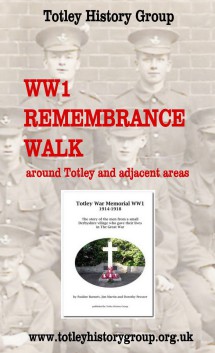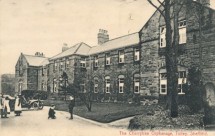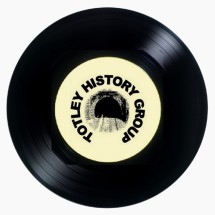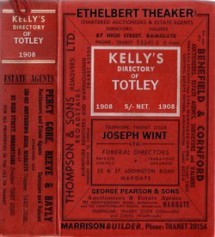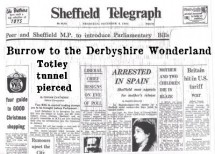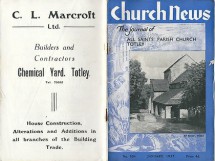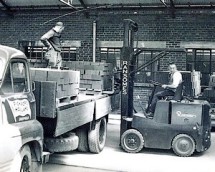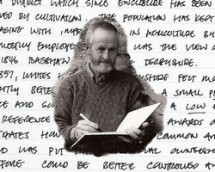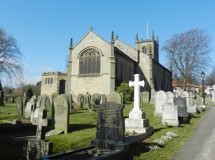Gazetteer of Totley and Totley Rise
In the past most dwellings were identified only by a name. In small towns and villages this would not have presented a great problem for the local residents in locating dwellings as they probably knew the majority of the other locals anyway.
As populations increased in size, however, it became obvious that a controlled system of street naming and numbering was needed. Street naming and numbering became the responsibility of local authorities and they were given the relevant powers by two pieces of legislation, firstly Sections 64 and 65 of the Towns Improvement Clauses Act 1847 and secondly Sections 17, 18 and 19 of the Public Health Act of 1925. This legislation requires the Local Authority to prepare street naming and numbering schemes and to maintain a good standard of street nameplates. In our area, house numbers were used for terraced cottages, including Grange Terrace, Shrewsbury Terrace and even Bricky Row. Only after Norton District was absorbed into Sheffield in 1934 did house numbers become commonplace.
In this alphabetical listing of streets in Totley and adjacent areas, the current house number is shown in bold type. House names in bold type still exist in the official postal address where there is no house number. Numbers in parentheses are provisionally matched usually by interpolation. Unless otherwise stated, dates refer to the first mention of the house name in our records.
Abbeydale Road South, Dore/Beauchief
Abbeydale House 1911
Beech Villas 1911
Brinkburn Grange (built circa 1873, demolished in 1938)
Brookside 1911
Cedar Villas 1901
Dilwyn 321
Elm Villas 1901
Glen View 1911
Ivy House 1911
Jowitt House (built pre 1877, demolished)
Licensed Victuallers Almshouses = Woodland View (built in 1879)
Oak Villas 1901
St. John the Baptist, Abbeydale (built in 1876)
St. John's Church Rooms (built in 1893)
Stanley Villa 1901
The Corner House 1925
The Glen 224 1925
The Poplars 1911
The Yews 1901
West View Cottage (built pre 1877, demolished)
Westra 319
Wood Bank 228 1925
Woodland View (built in 1879)
Woodlands 232 1877
Woodside 1901
Ashfurlong Road, Dore
Ashleigh House 17
Ashbrook 31
Blossom House 9
Gartton House 65
Leconfield 61
Middle Wicket 18
Moneyash House 1
The Birches 2
Willowcroft 28
Back Lane, Totley
Barn Cottage
Barn Wood House
Glen Rose 1907
Glenbourne 1909
Woodside 1901
Back Lane, Bradway
Brook Cottage
Brookvale 1911
Brookvale Cottages
Claybrook Croft
Ford Cottage
Northwest Cottages (demolished)
Riverside
Sheaf Cottage (=north end of Ford Cottage)
Stoney Brook
Tranmere Cottage (=middle section of Ford Cottage)
Baslow Road
Abbeydale Club 85-87 1898-1904
Avondale (216)
Berkeley (196)
Birkdale 182
Bridge House 6
Cartreff (214)
Claughton (190)
Coachman's House
Cross Scythes Hotel
Dale Bank 180
Fern Mount 353-355 (dated 1901)
Field Head 188
Glenville (218)
Grange Terrace (313-329) (dated 1889)
Greenoak Hall 193 (=Heatherfield Club) (built 1925)
Greenoak House 164-168 (built 1812)
Greenoak Lodge (built 1812)
Halfway House (=Cross Scythes Hotel)
Hazeldene (208)
Heatherfield Club 193 (built 1925)
Hilary (184)
Hill Crest 361-363 (dated 1906)
Inglenook 220
Little Haven 85 (built 1879)
Lulworth 194 1926
Lyndhurst (212)
Marstone Garage (built after numbers 73-77 were demolished,
demol.)
Moorland 357-359 (dated 1906)
Moorside 87 (built 1879)
Moor View (186)
Oakleigh 1911
Police Station 331
Queen's Club 85-87 1901
Queen's Temperance Hotel 85-87
Rookwood 79 (built 1879)
Roseneath (81) (built in 1879)
Stanmore (206)
Sunny Bank (83) (built in 1879)
The Birches 81-83 (built 1879)
The Cote 210
Totley Grange (built in 1875, demolished in 1964)
Totley Grange Lodge (built in 1875, demolished in 1964)
Totley Post Office 337 (dated 1882)
Vicarage 222
Victoria Villas (73-77) 1904 (demolished circa 1930)
Wetherby 1916
Windyridge (192)
Brinkburn Vale Road, Dore
Barna 2 1923
Brentwood 1 1912
Briar Bank 5 1908
Fern Bank 1914
Holm Lea 6 1911
Lynwood 4 1911
Pattysbrooke 3 1901
The Neuk 8 1923
Busheywood Road, Dore (houses on Devonshire Road are sometimes refered to as Bushey Wood, Dore)
Airlie (22) 1922
Ardfern 1924
Atherley 1931
Ayton Villa (Aytonville) 14 1911
Briar Dene 54 1933
Burngill/Bushgill 40? 1931
Chez Nous 60 1931
Claymer 12 1911
Clovelly 1928
Danby 6 1922
Edensor (8) 1923
Ellersley (16) 1911
Goathland 42 1923
Inglade 1931
Inglehurst (18) 1911
Ingoldmills 1931
Lealholm 4
Lea Royd 1931
Lingrow 2
Lincolme 72 1931
Lyngrove 1923
Maxstoke (20) 1911
Meryl 1931
Modwena
Monash 1931
Moorfield 1931
Morehayes (24) 1912
Moss Lea 1931
Oakdene (16) 1922
Oakley 1931
Randabel (10) 1911
Sherwood (10) 1931
Sherbourne 1923
Sunnings 1931
The Bushes 1923
Vingonia 1912
Butts Hill
Ash Cottage (built in mid 18th century)
Back Moor View
Butshill Terrace (demol.)
Cannon Hall (built in late 16th century)
Doris Cottage (built circa 1899)
Greens Cottage (rebuilt in 1987-89)
Moor View
Moorview House
Shrewsbury Terrace 1-6 (built circa 1875)
Vera Cottage (built circa 1899)
Canteen Lane (=Moss Road)
Cavendish Avenue, Dore
Alden 12 1939
Ashfurlong House 23
Ashwood 31 1939
Bay Trees 16
Bengairn 8 1938
Cavendish Grange 15
Cavendish House 9
Cavendish Lodge 15a
Fircroft 25 1935
Four Winds (16) 1928
Glencroft 20 1939
Greenclose 3
Holly Tree House 7
Ken-Bryn 1939
Laneside 1 1939
Limewood 14 1939
Llyswen 1939
Low Pastures 1939
Moorgate 1939
Nevill Holt 1939
Newlands 27
Norton Lees 11 1939
Oakdene 6 1939
Ristmore 1939
Rosely 17 1935
Sherwood 4 1939
Stainton 22
Sunningdale 19 1939
The Croft 18 1929
The House 2
Thistleknowle 29
Wensley Green 10
Woodsetts 26
Xericum 1939
Chapel Walk (=Chapel Lane)
Totley Wesleyan Methodist Chapel (=Chapel House) (built 1848, extended 1898, closed 1967)
Chatsworth Road, Dore
Aysgarth 1932
Coniston 1923
Edwiser Villa 1911
Endsleigh 24 1911
Edensor Villas 25 1922
Moorland 1 1911
Moorland View 3 1911
Newlands 22 1911
Oakleigh (Oaklea) 26 1911
Rosecroft 33
Rose Villa 1911
Roslyn 17 1925
Shandon 15 1923
South Dene 20 1911
Vernon Lodge 12 (dated 1910)
Devonshire Road, Dore (houses on Brinkburn Vale Road are sometimes
shown as Devonshire Road)
Allerton 1923
Ashbourne (12) 1911
Aviemore 3 1911
Ballymull (5)
Bircholme 38 1904
Brook Dene 6 1902
Brooklyn 16 1917
Brookfield 18 1911
Bushgarth 34 1912
Bushy Mount 32 1912
Cavendish Villas (11-13) 1911
Claremont 31 1912
Danby 1912
Devonshire House (22?) 1905
Devonshire Villas 19-21 1911
Drayton House 23 1911
Edgecombe 28 1925
Fairfield (1) 1911
Greyfriars (10) 1911
Hartington Villas 15-17 1911
Heatherleigh 36 1904
Langleigh (24?) 1908
Maisonette (5) 1911
Moorlands 25 1922
Oakhurst (20?) 1902
Reneville 1912
Resthaven (30?) 1911
Roseneath/Rosemeath (8) 1904
South Field (14) 1917
The Grove 1923
The Laurels (7) 1911
The Poplars 9 1911
Westthorpe (26) 1911
Widdecombe 1 1922
Winthorpe 30 1922
Woodville 29 1912
Dore (New) Road, Dore
Apsley House 1886
Ardendale 18 1892
Audrey Cottage 118 1925
Ashmount House 71
Brentnor 37 1911
Brinkley (4) 1896
Brooklands 1911
Cambria 184
Cranesby/Cranesbie 6 1902
Cresta 125
Croft House 42
Elm Lea 1892
Glenbourne 1886
Glenwood 14 1885
Heath Court 74a
Highlands 101
Hillside 1901
Ivy Cottage 1925
Ladyspring 64
Lilburn 28 1888
Limbrook (Lymbrook) 53 1901
Milton House 22 1881
Moorwinstow 99 built in 1912
Newstead House 1911
Norwood 1897
Oak Villa 1881
One Ash 84 1900
Passaford 26 1925
Pendennis 1911
Prospect Villa 1899
Redlands 45 1935
Ringstead 20 1899
Rose Lea 12 1881
Ryecroft 42 1899
Ryecroft Farm 1876
Ryecroft Lodge 103
Silverdale 2 1877
South Lawn 121 dated 1902
Summerville 1901
The Beeches 1901
The Corner House 1
The Firs 66 1901
The Grove (Grove Villa) 8 1901
The Laurels 1901
Thornbridge 30 1911
Thornsett 39? 1899
Throstle Nest 1925
Tilburn 1911
Tower House 16 1896
Wood Lea 10 1890
Furniss Avenue
Birch Close 1932
Corbiere 38 1932
Goffs Oak 1932
Greenlands 1932
Littleover 1932
Mooredge 1932
Shirley 1932
Spelderbanks 1932
The Hawthorns 1932
Wendover 1932
Wyngarth 1932
Glover Road
Albert Villa 1904
Alyburn
Fairfield Villa (5) 1904
Fern Dene (7) 1908
Norwood House (9-11) 1888
Oakleigh 1-3
Penrhyn 1925
Sudbury 1912
The Mount 1916
Thirlmere
Victoria Cottage
Woodview 1-3 1911 (demolished) between Oakleigh and Fairfield
Grove Avenue
Brentwood
Hillside
Windy Ridge
Grove Road, Dore
Bridge House 1877 (6 Baslow Road)
*Brook House (19-21) 1881, but dated 1885 (demol. 1978)
*Brook Lynne 17 1911 (demol. 1978)
Brookside 1881
*Dalston Villas 13-15 1911 (demol. 1978)
Glenroyd (5) 1898
Grove Cottage (=Bridge House)
Grove Lodge built 1836 (=Totley Brook Cottage?) 1
Grove Villa 1877 (=Grove Cottage, =Bridge House)
Holly Bank 11 1891
Horton Villa (3) 1898
*Marlborough Villas (25-27) 1906 (demol. 1978)
Sunny Vale 1898 (=Westgrove?)
Totley Brook Cottage (=Grove Lodge?)
Westgrove 6 1939 (=Sunny Vale?)
*Woodleigh House 23 1881 (demol. 1978)
Numbers 7-9 were built in 1925
* formerly occupied by the Dore & Totley High School
Hillfoot Road
Ashcroft
Avalon
Bryn Cottage 5 (dated 1704)
Cross Grove Cottage
Cross Grove House (built 1884)
Crown Inn
Crown Inn Cottage (demol.)
Elder Cottage
Forge House
Grove House 1851
Holly Tree Cottage (=1 Summer Lane) (Evans's Shop)
Juniper Lodge, Totley Grove
Mill House, Totley Grove
Moor Cottage
Moss Grove
Old Orchard
Rose Cottage 1901
School House
The Cottage
The Stables, Totley Grove
Totley Dale (=Grove House) 1851
Totley Grove (=Grove House) 1851
Totley Vale (=Grove House) 1851
West View
King Ecgbert Road, Dore
Applecross 10 1913
Beckhythe 1923
Blythwood 1921
Brentford 1923
Brentwood 1916
Claremont 14 1915
Glendene 1926
Grassmere 1928
Greystones 1922
Heatherlea 26
Highcliff 1923
Hogarth 13
Kenmore 12 1919
Langwith 6 1915
Mon Repos 1928
Moor View 46 1931
Netherfield 8 1913
Sunnycroft 2 1915
The Gables 4 1922
Uplands 18 1923
Lemont Road
Hawthorn Cottages 2-6 (dated 1876)
Lemont House 34 1901
Mona Villas 37-39 1909
Moorland View 19-25 (dated 1908)
Main Avenue
Avondale 36 1916
Belmont (8) 1911
Belvoir House 1925
Brenchley (18) 1910
Bronkley 1913
Brooklands 61
Byron House 32 1911
Croft View 1931
Dyffryn 1912
Eggerslack 4 1911
Ellerslie 6 1910
Elmstead 33
Ferndene 1911
Glenwood (42) 1925
Greenwood 1916
Heatherdene (2) 1910
Inglewood 40 1912
Ivy Dene 16 1911
Marina House 67
Marlbrook 69
Marson House (71)
Maycroft 22 1911
New Haven 1913
Osborne House (12) 1910
Rookwood 65
Rose Dene 1911
Rose Hill 38 1911
Ruskin Villa 34 1912
Ryburn 44 1916
Somerford 7 1925
St Hilda (24) 1912
Suncliff 63
Sunny Bank (14) 1911
The Gables 45
Trelwydon (20) 1911
Waverley (26) 1912
Whitecroft (10) 1911
Marstone Crescent
Moss View 13
Red Ridges 25-27
St Helens 24
Meadow Grove and Meadow Grove Road (=Princess Street)
Fairhaven 1925
Glenaire 1912
Homedale 1911
Silsoe 35 1925
The Bungalow 1911
The Newlands 5 1925
Mickley Lane
Brook Hall (built circa 1850)
Brook Hall Lodge (built circa 1850)
Brook Terrace 79-85 (built circa 1888, demolished circa 1956)
Cherry Tree Orphanage (=Mickley Hall) (built 1867-68)
Glover House (demol.)
Grindle Nook 1931
Shepley Spitfire (built 1979)
Mill Lane
Ivy Cottage (=Mill Cottage)
Mill Cottage
Poynton Water
Rolling Mill Cottages 1-4
The Cottage
Monybrooks Lane
Hop Cottage
Moss Road
Bole Hill Lodge 1850
New Row (=Summer Lane)
Old Hay Lane, Totley
Holder (=Old Hay)
Old Hay
Old Hay Cottage
Oldway (=Old Hay)
Oldway Forge (demol.)
Totley Forge (demol.)
Park Lane (=Sunnyvale Avenue)
Krithia
Prospect Place, Bradway
Braeside 1 1910
Casanova 7 1911
Holmfield 5 1911
Steep Bank 2 1931
The Bungalow 1 1910
The Poplars 9 1913
Winderton 4 1911
Prospect Road, Totley Rise (Bradway)
Bradway House 60 built in 1832
Braeholme 25
Braeview 25a
Dale View 1911
Derwent House 1916
Derwent Lodge 1922
Hayes Croft 157
Hill Crest 131 1911
Hill House 1909
Hill Top 10 1919
Moorhill 1912
Mount Pleasant House 133 1907
Overdale 129 1908
Ribble House 11
The Croft 138 (later known as 5 Rosamond Drive, demol. 2019)
The Dingle 172 1904
The Mount 1911
Winderton 1912
Ryecroft Glen Road, Dore
Oakwood 1
Quarry Road
Moss Lea Cottage 3
Quarry Cottage 1
Station Road (=Dore New Road = Dore Road), Dore
Strawberry Lee Lane
Hallfield Farm
Hollin House
Turner's Croft
Sunnyvale Road
The Hollies 33 1912
The Orchard 36
Udale Cottage 4 1912
The Crescent
Holly Cottage 4
The Green
Clonmoyle 10
Melinda 8
Sawston 6
The Grove
Astinley 59
Avalon 17
B illesbye 24
Brancote 9
Brandon 61?
Bryn Gwynt 35
Bryn Hyfryd 12
Burnlow 13
Charlton 27
Cheddleton 43
Conway 7
Cranston 25
Dungoyre 49
Ecclesbourne 37
Ed..emoor 23
Erthig 3
Glendevon 45
Glenholme 30
Halstead 55
Heath Cottage 29
Holly Bush House 38
Kendal 31
Modwena 19
Moorhaven 20
Mor..andale 22
Moss View 63
Moreska 10
Overlea 57
Passchendaele 11
Reneville 6
Ribbledene 5
Rose Marie 13
Rowantree 47
Sherbourne 33
Shirley 14
Strathmore 26
The Crag 4
Tonedale 21
Wayside 8
Westwood 1
Windlehurst 15
Winnereuk 41
The Quadrant
Alderly (16)
Aniron
Ankerdene
Beauforts
Bra Mora 40
Bron-Ow-Wil? 28
Brownlow
Bungalow
Burnside 5
Chez Nous 8
Craiganova
Craig-Na-Baa 26
Cramond
Daneshill
Enya 3
Glenbrook 44
Glenwood 34
Halesmere
Hazeldene 1924
Haylebra? 36
Holmleigh
Hollycroft (24)
Hollywood 14
Inglenook 7
Littleholme
Lynwood
Marklyn
Redcote 10
Roseville
Rysdale 1
Sand Beck
Summerville 21
The Bungalow (22)
The Nookin (20)
Trefusis
Tregotham 18
Trenance/Trarance 11 (1929)
Wigmore 12
Windyridge 9
Totley Bents Road
Bank View Farm
Monnybrook Cottages (rebuilt 1985)
Sunnybank 1911
The Grouse
The Poplars
Totley Brook Road, Dore
Agardsley (142) 1911
Arrandale (134) 1923
Ashleigh (92) 1911
Avondale (86) 1911
Belmont 108 1910
Blythwood (102) 1902
Bonnyrigg (136) 1911
Brook House 98 1890
Brook Leigh 126 1911
Brookside (144) 1911
Brookwood 1901
Cotsford 42 1923
Cotswood 42 1922
Daleside 22 1903
Dovedale (2) 1911
Dunedin (138) 1911
Eastbourne 36 1911
Fernleigh 114 1904
Fernleigh Mount 116
Greenlawn (20) 1911
Grendon (96) 1911
Hamilton House (140) 1911
Hazelbadge 1923
Holly Dene (104) 1911
Homefield (122) 1911
Ingledew House 1900
Inglewood 24 1911
Kengarth (Kingarth) 90 1911
Kilmington (110) 1911
Kirkleigh (16) 1911
Lyndhurst (14) 1911
Meadow View 1923
Melrose (106) 1911
Moor Cottage 18
Moor View 146 1912
Moorlands 132 1911
Mostyn (98) 1911
Norbury 1912
Oakdene 94 1911
Oakleigh 26 1912
Oakhurst (4) 1911
Prospect House (10) 1911
Rookwood (6) 1902
Rose Bank (80) 1880
Rose Villa (82)
Rose Lea (142) 1927
Runswick (134) 1911
Sherwood 1922
Silverdale 1923
Skeltonthorpe (18) 1931
South View (120) 1911
Springfield 8 1911
Sunnyside (122) 1911
Thornfield 1896
Thornleigh (100) 1911
Trevarrian 124 1923
Waverton 40 1912
Werneth 44 1912
Westbourne 38 1911
Westminster 86 1925
Wingrove 112 1911
Woodview (12) 1911
Wyvenhoe 1923
Totley Grove Road (=Grove Road)
Totley Hall Lane
Elder Cottage (demolished in 1932 for the new Fleur)
Fleur de Lys Hotel (rebuilt 1933)
Hall Lane Barn
Hall Lane Farm
Lowfield Hall (demolished in 1999)
School House (dated 1827)
South Cottage (modern, formerly 3 cottages)
The Lodge (dated 1887)
Toft House (built circa 1813)
Toft House Cottage (built 1813)
Totley Hall (dated 1623 and 1883)
Totley Hall Lane Farm
Turnpike Road (=Baslow Road)
Twentywell Lane
Broomfield 94 1898 (Dore & Totley High School)
Llanover 98 1898
Vernon Road (Dore)
Arrandale 32 1931
Victoria Road, Bradway (=Queen Victoria Road)
Alma Villas 44-46 1907
Ashcroft 70 1925
Balaclava House 62 1900 (demol. and rebuilt)
Bella Vista/Belle Vista 1919
Brentwood 10 1911
Chestnut Villas 1905
Cliff Cottages 1911 27-29
Cyprus Mount 1881
Cyprus House 1889
Ellerville/Ellaville 66 1931
Fern Ghyll 115
Garfield Villa 125 (dated 1936)
Hillside 98 1909
High Croft 1916
Holly Lodge 34
Holly Mount 1911
Journey's End 117 1936
Keppel Gate 30-32
Lathkil 1919
Lynton 1912
Machin Croft 18 1919
Marne Villas 1919
Merryfields 26 1911
Middlewood 1911
Moor View 90
Moorland View (52-54) 1893
Morvena 1926
Nestleton 1916
Oakdene 139 1913
Oakview 1911
Oakwood 60 1895
Overdale 1931
Pansy Cottage 27 (recent)
Pear Tree Cottage 29 (recent)
Riseholm 1911
Somerleigh House 1911
St Ives 1908
Stanley Villas 1-4 1891
Steep Bank 1923
Sunnybank 1922
The Bungalow
The Moorings 52 1925
Tree Haven 133 (modern name)
Victoria Cottage 46
Willow Cottage 34
Woodbank 96 1895
Woodbine Cottage 39 1901
Woodbine House 39
Woodland House 64 (demolished and rebuilt)
Woodland Villas 48-50 (dated 1873)
Woodlands 131 1936
Yewcroft 104? 1912
Well Bents Lane( =Penny Lane)
Search Our Website Here
Future Meetings
April
May
June
Unless stated otherwise our meetings are held in Totley Library on the 4th Wednesday of each month at 7.30pm.
Pauline Burnett's book The Rise of Totley Rise has been revised and updated. It tells the story of this small piece of land from 1875 when there was only a rolling mill and chemical yard alongside the river a mile from Totley, through Victorian and Edwardian times, two world wars and up to the present day. It has 94 pages including a useful index and many illustrations from private collections. The book is available now from Totley Rise Post Office priced at £5, or through our website when an additional charge will be made to cover packing and postage.
A few copies are still available of Sally Goldsmith's book Thirteen Acres: John Ruskin and the Totley Communists. Totley was the site of a utopian scheme funded by art critic and social reformer John Ruskin. In 1877 he bought 13-acre St. George’s Farm so that nine Sheffield working men and their families could work the land and, to keep themselves busy, make boots and shoes. Sally tells an engaging story from our history with a quirky cast of characters including Ruskin himself, the poet and gay rights activist Edward Carpenter and Henry Swan, a cycling, vegetarian artist and Quaker. The book is available to order online from the The Guild of St. George by following this link.
A recently discovered box of WWII correspondence reveals the story of how a small group of ladies from Dore and Totley recruited knitters from the west of Sheffield and how their efforts made them the country's greatest provider of Comforts for the Minesweeping crews of the Royal Navy. The story is told in Knit For Victory, a new book from Totley History Group. Written by Pauline Burnett, it has 82 pages and many illustrations. It is on sale in local shops and via our website. Further information about the correspondence is in this inside page of our website: Dore & Totley Minesweeping Trawlers Comforts Fund.
The story is told in Totley War Memorial WW1 of the ten men from our village who gave their lives in the Great War. Written by Pauline Burnett, Jim Martin and Dorothy Prosser, a chapter is devoted to each of the soldiers with a family tree followed by as much information as could be discovered about the men and their families. There is also information about their military careers and the actions in which they lost their lives. The book has 64 pages and is illustrated throughout with photographs of the men, their families and the houses where they lived.
Totley All Saints' Church Parish Magazines for the years 1985-2006 with notices of baptisms, marriages and funerals and accounts of spiritual, educational, charitable and social matters in the village. Scanned in full, including advertisements from local traders.
In 1893 during the building of the Totley Tunnel there was an outbreak of smallpox amongst the navvies which spread to some of the local population. 17 people were buried in communal graves in Dore Churchyard, 6 from "Green Oak" (Lemont Road). The severity of the outbreak was principally caused by overcrowding and insanitary conditions in lodging houses .
Kathleen Grayson was a 39 year old housewife when WW2 broke out. She volunteered for the ARP and became an ambulance driver. During an air raid on Sheffield in July 1941, and despite her own injuries, she managed to get a seriously injured casualty to hospital. For this she was awarded a commendation from King George VI. Together with her friend Hilda Duffy, Kathleen also assembled a team of knitters to provide essential warm clothing for the men serving on the minesweepers patrolling the North Sea.
We have recently bought at auction the WW2 memorabilia of Douglas Platts whose family home was at Hillside, 98 Queen Victoria Road. After the war Douglas returned to his civilian occupation working in the family scissors manufacturing business. He lived in our area for the rest of his life.
We are very grateful to Mrs Valerie Taylor of Dore for lending us the title deeds to Lower Bents Farmhouse which is reputed to be the oldest surviving building in the area with a proven history back to 1621. We have now scanned and transcribed the deeds which could be particularly interesting to anyone with a connection to the local Fisher, Dalton and Marshall Families.
Until 1844, when Dore Christ Church parish was created, Totley township was part of Dronfield parish. We have now transcribed the burial records for former Totley residents at St. John the Baptist, Dronfield for the period 1678-1870 and at St. Swithin, Holmesfield for the period 1766-1901.
Whilst researching the history of the Dalton Family we found it useful to transcribe a number of early Wills and Inventories. These and those of many other Totley, Dore and Holmesfield people dating from between 1594 and 1856 have now been added to our website.
St. Swithin's Church, Holmesfield pre-dates Dore Christ Church and was the place where many of the people from Totley worshipped and were baptised, married and buried. Read the inscriptions on more than 750 gravestones in the churchyard including those of Mr. and Mrs. William Aldam Milner of Totley Hall, Jessie Matilda Tyzack (nee Fisher) of Avenue Farm, and Rev. J. A. Kerfoot of St. John's, Abbeydale.
Thomas Youdan was a music hall proprietor and benefactor who was living at Grove House, Totley in 1867 when he sponsored the first football knockout competition in the world for The Youdan Cup.
The words Millhouses Cricket Club can be seen in the background of team photos which are likely to date from between 1905 and the early 1920s, very probably pre-war. They were lent to us by Garth Inman who can identify his great uncle, Cecil Inman, in some of the photos and would like to know when they were taken and, if possible, the names of others present. Please take a look to see whether you can put names to any of the faces.
Josiah Hibberd was seriously injured whilst working on the construction of the Totley Tunnel in 1892. He died on 9 May 1897 at the age of 38 having apparently spent most of previous five years in hospital.
Bradway House was built around 1832 by Henry Greaves, a farmer, together with two adjacent cottages. We have traced most of the occupants of the property from these early days up to the start of World War Two.
We have transcribed the baptisms records at St. John the Evangelist, Abbeydale from when the church was consecrated in 1876 until just after the start of World War 1. The records are arranged in alphabetical order based upon the child's name and show the date of baptism, the names of the parents, their home location and occupation.
Nick Kuhn bought an original 1920s poster which had this owners' blind stamp in one corner. The stamp almost certainly refers to a house named Wigmore that was built in the late 1920s or early 1930s. The first occupiers that we can trace are John Howarth Caine, a district mineral agent for the LNER, his wife Florence Jane (nee Prince) and daughter Doris Mary. The Caine family lived at Wigmore until 1936 by which time the house would have been known simply as 12 The Quandrant.
George Griffiths died on 13 December 1888 following an explosion during the sinking of number 3 airshaft at Totley Bents. His widow Florence died shortly afterwards and his two daughters Maud and Annie were adopted separately. Whilst Annie lived the rest of her life in Yorkshire, Maud emigrated to Australia in 1923 with her husband, John Burrows, daughter Margaret and son Jack, pictured above.
George Wainwright was said to have been born in Bamford, Derbyshire in 1714. He learned the trade of linen weaving and moved to Totley after his marriage on 1744. He became an ardent follower of John Wesley who paid many visits to Sheffield and who would have passed through or close to Totley. Preaching was at first conducted out of doors and when Wesley's preachers became harassed by a mob of Totley ruffians in 1760, George offered them safety of his own home. He remained a Methodist for all of his long life, dying in Dore in 1821 at the reputed age of 107.
Oakwood School was started by Mrs Phoebe Holroyd in 1925 initially as the Firth Park Kindergarten and, by 1927, as the Firth Park Preparatory School. Phoebe was still working at the school almost fifty years later when she was well into her seventies. We would like to hear from anyone with memories of the school.
James Curtis was born at sea aboard HMS Chichester in 1790. He enlisted as a Private in the 1st Grenadier Regiment of Foot Guards in Sheffield in 1812 and served in Spain and Portugal during the Peninsular War. He later fought in France and Belgium taking part in the Battle of Waterloo. In later life James lived at the Cricket Inn where his son-in-law William Anthony was the licensed victualler. He died in Heeley in 1882 aged about 91.
Charles Paul lived in Totley in later life. He was a local historian and archaeologist who was an authority on the history of Sheffield, especially the two areas he knew best: Attercliffe and Ecclesall. His books and letters to local newspapers were published under the Latin form of his name Carolus Paulus.
Towards the end of the 19th century Totley Hall gardens became a well known beauty spot that attracted many hundreds of visitors from Sheffield on open days and the rock gardens became one of its most popular features. Mrs Annie Charlesworth sent us six glass transparencies of the rock gardens taken, we believe, in the early years following the Great War.
Anton Rodgers send us photographs of three water-colours that had been bought by his grandfather at a sale of the contents of Abbeydale Hall in 1919. One was of a scene said to be in York by A. Wilson. A second was of a seated child with a dog believed to be pianted by Juliana Russell (1841-1898). The third was of Lake Como, by Ainslie Hodson Bean (1851-1918) who lived for much of his life on the Riviera and in North Italy.
A Canadian correspondent sent us photographs of a set of silver spoons that were bought in a small town in British Columbia. The case contained a note signed by Ebenezer Hall indicating that they were a wedding gift to Maurice and Fanny Housley. We think we may have traced how they got to Canada and where they might have been since.
Green Oak Park was opened on 23 March 1929 on land that had been bought by Norton District Council from John Thomas Carr, a farmer and smallholder of Mona Villas. In later years, the buildings were used by the Bowling Club (the green having been built in 1956) and by the park keeper. However, the buildings appear to have been constructed in several phases, the oldest of which predates the park to the time when the land was used for pasture.
We believe the old Totley Police Station at 331 Baslow Road was built around 1882. Two lock-up cells were excavated just below floor level in the summer of 1890. We have traced the Derbyshire Constabulary police officers who lived there from John Burford in 1886 to George Thomas Wood who was there when Totley was absorbed into Sheffield in 1934.
David Stanley lived in Totley Rise in the later years of his life. Born in Bulwell, Nottinghamshire, he joined the 17th Lancers when he was 19 and rode in the Charge of The Light Brigade at the Battle of Balaclava where he was seriously wounded. For the first reunion of veterans in 1875, he told his story to a reporter from the Buxton Herald.
This picture postcard was addressed to Miss Abell, Holly Dene, Totley Brook Road and posted in Rotherham on 10 December 1907. Edith Annie Abell was born on 4 February 1887 in Sheffield and her family came to live in our area in the 1900s, staying for the rest of their lives.
Charles Herbert Nunn enlisted in the British Army on 23 August 1915 and was sent to France on 18 December 1915 to served with the British Expeditionary Force. In March 1916 it was discovered that he was underage and he was returned home. Shortly after his 18th birthday he re-enlisted and was again posted abroad where, in addition to this trio of medals, he was awarded the Military Medal.
This certificate was awarded jointly by the Red Cross and St. John's Ambulance to Isaac Henry Williams, of Lemont Road, for his services during WW1 as a stretcher bearer. We are seeking anyone who can help us pass it on to a living relative.
In 1832 Samuel Dean pleaded guilty to stealing a quantity of lead from the Totley Rolling Mill and was sentenced to seven years transportation to Australia. He sailed on the Mangles and upon arrival in New South Wales he was sent to work for William Cox, the famous English explorer and pioneer. After receiving his Certificate of Freedom in 1840, Samuel became a farmer and went on to have a very large family. Samuel was born in Whitechapel around 1811 to parents Samuel Dean Snr. and Susannah Duck. His descendant Sarah Dean would like help in tracing his ancestry.
Ellen Topham was born in 1889 in Nottingham. Her parents had been living together since 1862 but had never married so it was most unusual that, after their deaths, Ellen was accepted into Cherrytree Orphanage. Even more so since her father, Snowden Topham, had been acquitted somewhat unexpectedly in a widely reported manslaughter trial. Ellen remained at Cherrytree until her death from pulmonary tuberculosis at the age of 15.
Mabel Wilkes was a resident in Cherrytree Orphanage between 1897 and 1905. Her granddaughter Sally Knights sent us these images of a book presented to Mabel as a prize for her writing. Sally also sent us some personal memories of her grandmother and a photograph of a locket which contains portraits of Mabel and her husband Septimus Gale.
John Henry Manby Keighley was living at Avenue Farm when he enlisted in 1916. He fought in France with the Cheshire Regiment but after home leave in early 1918 he went missing. The Army were unable to determine whether he had deserted or returned to the front and been either killed or captured by the enemy. In August 1919 he was formally presumed killed in action but it appears he did not die but returned home to his family.
Horace Ford was admitted to Cherrytree Orphanage on 26 October 1888 at the age of six. He left at the age of 14 to become an apprentice blacksmith and farrier. Soon after his 18th birthday Horace enlisted in the Imperial Yeomanry to serve his country in the war in South Africa. His letter home to his Orphanage mentor tells of the lucky escape he had in battle.
Pat Skidmore (née Sampy) lived on Totley Brook Road from 1932 to 1948 before her family moved to Main Avenue. In this short article she remembers her time at Totley All Saints School where she was a contemporary of Eric Renshaw and Bob Carr.
As we have nowhere to exhibit memorabilia and artifacts, we have created a Virtual Museum instead. The latest addition to our collection is this double-sided Totley Rise Post Office oval illuminated sign which was on the wall of 67 Baslow Road before the Post Office business transferred to number 71. Please contact us by email if you have things that you own and would like to see added to the virtual museum.
Conway Plumbe was a man of many talents who came to live in Totley Rise around 1912. As a young man he had poems published by Punch magazine and is remembered in modern collections of WW1 poetry. A number of his paintings were accepted by the Royal Academy. An engineering graduate of London University, he joined the Civil Service where he rose to a high level as a factory inspector, publishing two books on the subject and giving a series of talks on workplace health and safety on BBC radio during WW2. In retirement he wrote a philosophical-spiritual work called Release From Time.
Inside Totley Rise Methodist Church there is a Roll of Honour commemorating the soldiers from its congregation who served their king and country during the Great War. For all but one of the 28 names the soldier's regiment is recorded in the next column. The exception is David Cockshott for whom 'killed in action' is written alongside yet he appears on no war memorial in our area and no record of a mortally wounded soldier of that name is to be found. We think we have solved the mystery.
Mrs. Kate Plumbe moved from Mansfield to Totley Rise with a number of her family in 1913 and became closely involved with the Totley Union Church. Her daughter Winifred became a missionary and headmistress in Calcutta for over 38 years following which she returned home to live with her sister Hilda on Furniss Avenue. Hilda had also been a teacher, missionary and, like her mother, a volunteer at St. John's VAD during WW1.
Thomas Glossop was a cutler and razor manufacturer who was well known amongst cricketing and gardening circles. Despite going blind, he was able to continue his hobbies with remarkable success
The Totley Union Cycling Society Prize Giving and Fete was held on the fields near Abbeydale Hall on 18 July 1914. Anne Rafferty and Gordon Wainwright have named some of the people in two wonderful photographs of the event. Can you identify any more for us?
The Tyzack family are well known in our area for owning iron and steel trades at Walk Mill, Abbeydale Works, Totley Rolling Mill and Totley Forge. This article covers the history of the family from the late 18th century when William Tyzack the founder of the company was born until the early 20th century when Joshua Tyzack farmed at Avenue Farm, Dore.
Walter Waller Marrison moved to Totley around 1897 with his wife and their two young sons. He was a house builder who constructed properties around Totley Brook and Greenoak before ill health forced him to take up less physically demanding work. In 1904 he took over the tenancy of the grocers and off licence at number 71 Baslow Road. After his death in 1908, his widow Kate and later their eldest son Jack continued to run the business until it was sold in 1934.
Ron Wijk of Nieuw-Vennep in the Netherlands has sent us two scanned images of drawings of old cottages made by the celebrated Dutch painter, Anton Pieck (1895-1987) simply annotated "Totley", and wondered whether we could identify their locations.
We would like to thank Christopher Rodgers for bringing to our attention this fascinating log of the 85th Sheffield (St. John's and Totley Orphanage) Wolf Cub Pack for 1927-45. The log is published jointly by Sheffield Scout Archives and Totley History Group as a free PDF download. It is illustrated by no fewer than 92 photographs and is supported by a comprehensive index and biographies of some of the main participants.
Following our Open Meeting event on School Days, Roger Hart, Howard Adams and John Timperley have each written to us with their memories of Norwood School, which was located in the rooms attached to the Dore & Totley United Reformed Church on Totley Brook Road.
On 22nd July 1909 the children of Dore and Totley Schools celebrated by a pageant the union of England under King Ecgbert which took place at Dore in AD 827. The pageant was devised and written by Mrs Sarah Milner and her daughter Marjorie and performed in a field close to Avenue Farm in front of a large audience. Photographs of the event survive together with a fragment of the script.
John Edward Greenwood Pinder had lived all 46 years of his life in Totley but on census night, Sunday 2 April 1911, he was not at home; he was in Derby Gaol serving a sentence of three months hard labour. From the age of 20, John had been in and out of local courts for a series of minor offences including drunkenness, assault, wilful damage and night poaching. Finally he was sent to gaol for cutting down and stealing 86 small trees which he sold in Sheffield market for Christmas.
We have already transcribed the census returns for Totley, Totley Rise and Dore. Now we have transcribed Census Strays. These are people who were born in Totley but are missing from our earlier transcriptions. They may have been living, working or studying elsewhere or just away from home on the night the census was taken. Two people were in prison. Others were in Union Workhouses, hospitals and asylums. Fully indexed strays from the 1851, 1861, 1881, 1891, 1901 and 1911 censuses are available now.
We wish to thank Gillian Walker for allowing us to digitize an archive of material about the 1st Totley Scout Group. Most of the material was collected by Arthur Percival Birley in the period 1949-51 and there are many interesting documents pertaining to the building of the scout hut on Totley Hall Lane. In addition four Newsletters survive, two from the 1940s and two from 1971.
We are grateful to Angela Waite and All Saints' Parish Church for giving us access to baptismal and kindergarten birthday rolls dating from 1926 to 1941. We have transcribed the names, addresses, birthdates and baptismal dates and created an alphabetical index of entries for you to search.
Edmund Sanderson, a Sheffield estate agent, aquired the land on either side of the old drive to Totley Grove in 1874 and divided it into plots for development. He called it the Totley Brook Estate. But before many houses were built, the estate road was severed in two by the building of the Dore & Chinley Railway line. The eastern end of the road became the cul-de-sac we now call Grove Road.
John Roberts was born in Sheffield in 1798. He became a partner in one of the leading silversmiths firms in the city before moving to Abbeydale Park in 1851 and extending the house in Victorian gothic style. He paid for the building of St. John's Church and was believed to dispense more in charity than any other person in the neighbourhood including his protege Ebenezer Hall.
The Coke Family owned the Totley Hall Estate from 1791 to 1881. With the aid of a family tree to guide us, Josie Dunsmore takes us through the story of their tenure.
When the Rev. D'Ewes Coke inherited the Totley Hall Estate in 1791 it had two farms. Josie Dunsmore tells the story of how the two farms were combined under the tenancy of Peter Flint with the aid of field maps drawn by Flint himself and later by the Fairbanks family.
Do you think you recognize this face? More than sixty photographs of the girls and teachers at Hurlfield Grammar School for Girls in the 1940s were given to Totley History Group by Avril Critchley, who was herself a student at the school. The collection includes fifteen form photographs from June 1949. There would have been a number of girls from the Totley area attending the school in those days.
Christine Weaving tells the story of her 2 x great uncle George Edward Hukin, a Totley razor-grinder, and his life-long friendship with the academic, poet, writer, and free-thinker Edward Carpenter.
Eric Renshaw (pictured here on the right with Bob Carr) grew up and lived in Totley from 1932 to 1960. Many of his memories are of a sporting nature.
We are very grateful to Gordon Grayson for giving us this splendid sale document for the Norton Hall Estates, following the death in 1850 of Samuel Shore. The estates included a large part of Totley and the document has maps and illustrations, plus schedules of land and property with the names of tenants. We have also added a transcription of the entries for Totley and Dore.
Watch this Youtube video of the talk given by Dr. Mark Frost and Sally Goldsmith on Ruskin, Totley and St. George's Farm. The talk was hosted by Totley History Group on 20th May 2015 as part of the Ruskin in Sheffield programme. Also enjoy a video of the outdoor performance Boots, Fresh Air & Ginger Beer written by Sally.
When Jacqueline A. Gibbons became interested in what made her father tick, it began a journey through WW1 archive records and led to her flying from Toronto to visit the house and village where he lived and the countryside that he so much enjoyed. Jacqueline reminds us that in the early 20th century Sheffield was a driving force of industry and that Totley was the place where many of its remarkable people lived and where they formulated their ideas.
Edgar Wood was the designer of The Dingle, 172 Prospect Road, built in 1904 for Rev. William Blackshaw, the founder of the Croft House Settlement. The house, together with its western terrace and boundary walls, has now been awarded Grade II listed building status.
What was probably "the most perfect little garden railway in existence" in 1910 was to be found in the grounds of Brook House, Grove Road, the home of its designer and constructor, Guy Mitchell. Look at some wonderful photographs and read reports in newspapers and a full appreciation in Model Railways magazine.
We have now completed our transcription of Totley School's Admission Records for the period from 1877 to 1914. There is also a useful index to the names of the scholars and to their parents or guardians. We are very grateful to Sheffield Archives and Local Studies Library for allowing us to transcribe and publish these records and for permission to reproduce the photograph of a specimen page of the register.
On 8, 9 and 11 November 2014 Totley History Group held an exhibition at Dore & Totley United Reformed Church to commemorate the centenary of the First World War. Below are additional links to some of the photographs we were lent and stories we researched especially for the exhibition.
Oscar Creswick was a local farmer who served with the Army Service Corps in Salonika and who after the war returned to Totley to become the innkeeper of the Cricket Inn and a member of the village's successful tug of war team.
Walter Evans was a market gardener who also ran a small grocery shop on Hillfoot Road when war broke out. He fought with the Machine Gun Corps at the fourth battle of Ypres. After the war, Walter ran a grocers shop at the top of Main Avenue.
Fred Cartwright was another Totley soldier who survived the Great War. He fought in France and Belgium and although he wasn't wounded he was gassed and was home on sick leave when his daughter was delivered by Nurse Jessop during a snowstorm in January 1917.
Maurice Johnson joined the Yorkshire Dragoons, a territorial unit, on 1 Jan 1914 and so was called up at the very start of the war. He fought throughout the war on the Somme, at Ypres and at Cambrai. After demobilization in 1919 Maurice returned to his old occupation in the steel industry.
Bill Glossop lent us a letter written by his father, William Walton Glossop to his wife describing life in the army during training in the north east of England and asking her to keep him in mind with the children.
The photo above provides a link to an album of photographs taken of WW1 Hospitals at St. John's, Abbeydale and the Longshaw Estate.
Nora Green, of Chapel Lane, was only 14 when war broke out. In 1914 she was ill with diphtheria and was sent to the isolation hospital at Holmley Lane, Dronfield. Nora recovered and wrote a letter of thanks to one of the hospital staff and the reply she received survives.
We have collected together on this page the names of local men who appear on various War Memorials and Rolls of Honour in Totley, Dore, Abbeydale, Norton, Holmesfield and Dronfield.
Unfortunately we were unable to identify all the photographs we were lent of Totley Soldiers. Please take a look at this album to see if you recognize any of the missing names.
This walk visits locations that have strong associations with Totley during the First World War. It includes the homes of the ten soldiers from the village who lost their lives, the auxiliary hospitals, war memorials, and even the rifle range on which the soldiers trained. Take a look at the first draft of a new walk by the authors of "Totley War Memorial WW1 1914-1918"
We wish to thank the Trustees of Cherrytree for giving us permission to publish transcriptions of the Cherrytree Orphanage Admissions Book entries for the years 1866-1929. There is also an alphabetical index for you to look at.
With more people having access to faster broadband and mobile networks, we have uploaded seven full and unedited oral history recordings and also added more short excerpts for you to listen to.
Our transcriptions of local trade directories have been expanded to cover the 95 years from 1837-1932 and have also been indexed. From the days when there were a handful of farmers, stone masons, saw handle makers & scythe grinders to the wonders of the Totley Bridge Garage Company, Betty's Boudoir and The Heatherfield Shopping Centre.
We continue to add to our Totley Newspaper Archive. Recent entries have included several about The Plumbe Family, Thomas Glossop and accidents during the construction of Totley Tunnel.
Totley Church of England Parish Magazines for the years 1922-1939 and 1948-1967 with notices of births, marriages and deaths and accounts of spiritual, educational, charitable and social matters in the village.
Around 90 photographs taken by Stuart Greenhoff for his thesis A Geographical Study of Dore and Totley including several of Totley Moor Brickworks. Superb!
Chronologically ordered snippets of information recorded by Brian Edwards during his many years of research into our local history.
Read the inscriptions on more than 700 gravestones in the churchyard.
Visitors since 24 Sep 2012:



